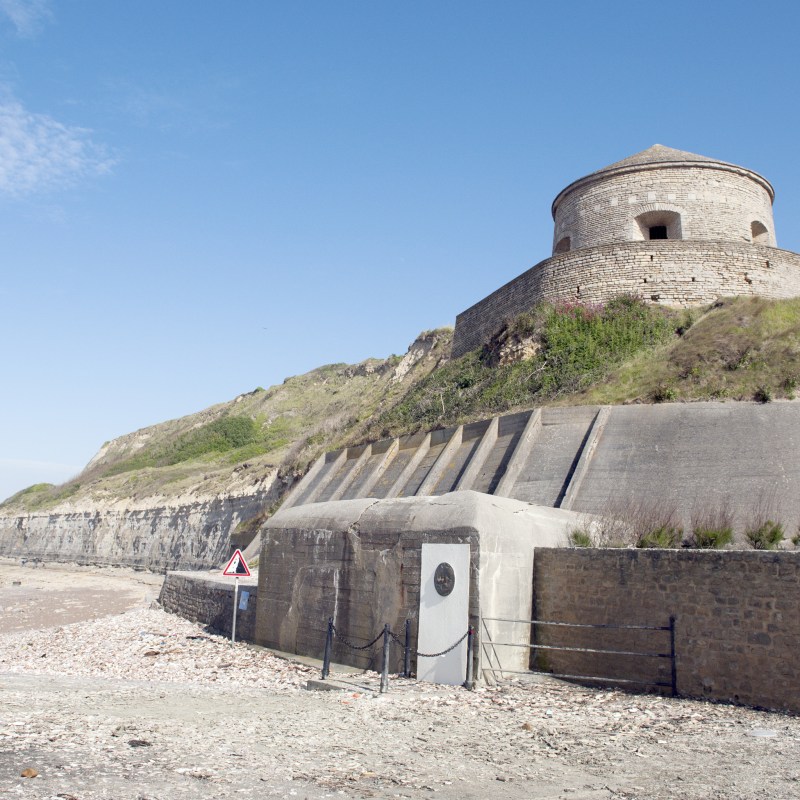
Masterminded by a Kansas farm boy-turned-West Point-educated general, D-Day is often cited as the turning point of World War II. As dawn began to break on June 6, 1944, soldiers, sailors, and airmen from 12 nations executed General Dwight D. Eisenhower’s Operation Overlord and carried out the largest amphibious attack in history.
Videos by TravelAwaits
While there are hundreds of World War II museums, memorials, and other sites around the world, the invasion of Northern France was a significant victory against the German soldiers and the allied Axis powers and helped change the course of history.
From the sandy beaches of Normandy to the modest red-brick school building in Reims where the Germans surrendered, ending the six-year global conflict, these are the most moving WW2 sites to visit in France.
13 WW2 Sites in France You Must Visit
1. Museum Of The Liberation Of Paris, Paris

The newly restored Museum of the Liberation of Paris recently opened in conjunction with the 75th anniversary of the city’s release from Nazi power. Located in Paris’s 14th arrondissement, just across the avenue from the Catacombs of Paris, this beautiful 18th-century gatehouse chronicles the actions of Jean Moulin and General Philippe Leclerc, two of the most prominent figures of the French Resistance.
Explore hotels and Airbnbs near Museum Of The Liberation Of Paris, Paris
2. Museum Of National Resistance, Champigny-Sur-Marne
Less than 10 miles to the east in Champigny-sur-Marne, the National Resistance Museum is located in a 19th-century mansion overlooking the Marne River. There is currently no fee to visit this collection, which focuses on the French Resistance between 1929 and 1947.
It should be remembered that on D-Day the Resistance and French troops played a crucial role in the Allied invasion of Normandy. The Free French Forces, under General Charles de Gaulle, contributed significantly to the liberation of their homeland from German occupation. Their bravery and sacrifice on the beaches of Normandy marked a pivotal moment in World War II.
It is important to note that this World War II museum is one of several dedicated to the Resistance throughout France. You’ll find similar experiences in Lyon, Grenoble, and Limoges.
Explore hotels and Airbnbs near Museum Of National Resistance, Champigny-Sur-Marne
3. Pegasus Museum And Memorial, Ranville

Leaving the City of Lights and heading northwest toward the English Channel, the Pegasus Museum and Memorial in Ranville pays homage to the men of the 6th Airborne Division of the British Army. Several hours before the D-Day invasion, they surprised the German forces, capturing the Pegasus Bridge that spanned two parallel waterways, the Canal de Caen a la Mer and the Orne River. This pre-invasion act was essential for clearing a route for the troops scheduled to land on Sword Beach at the break of dawn.
Explore hotels and Airbnbs near Pegasus Museum And Memorial, Ranville
4. Caen Memorial Museum, Caen
Cross the Pegasus Bridge and head to the northern edge of the city of Caen to visit the Caen Memorial Museum. The recommended starting point for your visit leads down a dark spiraling walkway that details the lingering turmoil from World War I that led to World War II. After covering WW2 in great detail, the museum addresses post-WW2 issues like the Cold War.
Explore hotels and Airbnbs near Caen Memorial Museum, Caen
5. Beaches Of Normandy
The 50 miles of coast stormed by the allied forces on D-Day were divided into five beaches that stretched from Ouistreham, directly north of Caen, to Vierville-sur-Mer. While American forces led the invasion of the western beaches of Utah and Omaha, British and Canadian troops commanded the surprise attack on Gold, Juno, and Sword Beaches to the east.
If time allows, I recommend visiting each of these beaches, because learning about WW2 from the perspective of the other nations is incredibly enlightening.
My recommendations from east to west:
Sword Beach

The Grand Bunker Museum is a five-story German command center that displays everything from German machinery and equipment to examples of everyday life in the concrete fortress.
Juno Beach
To better understand the contributions Canada made to World War II, visit the Juno Beach Centre.
Gold Beach
Continuing westward, the Gold Beach Museum details how Britain prepared for and participated in D-Day.
Omaha Beach

The Omaha Beach Memorial Museum honors the 2,400 men who died on Omaha Beach during the invasion of Normandy.
Utah Beach
If you only have time to visit one Normandy beach museum, make it the Utah Beach D-Day Museum. Built on the spot where the first American troops landed, this D-Day museum is one of the most comprehensive.
Explore hotels and Airbnbs near Beaches Of Normandy
6. Arromanches-Les-Bains
As you make your way westward along the Normandy coast, watch for the remains of the Mulberry harbors floating off the coast near the town of Arromanches-les-Bains. These floating roadways connected naval ships to the sandy shore, allowing the Allies to quickly unload personnel and equipment during the attack. To learn more about this wartime invention, visit the D-Day museum in Arromanches. France really yields fascinating places to explore for World War II history buffs.
Explore hotels and Airbnbs near Arromanches-Les-Bains
7. Normandy American Cemetery And Memorial, Colleville-Sur-Mer

One of the most emotional experiences an American can have in Normandy is to stand among the nearly 10,000 white limestone crosses and Stars of David on the manicured green lawn above Omaha Beach in Colleville-sur-Mer. The average age of the brave men (and four women) buried at the Normandy American Cemetery and Memorial is 24, and the weight of their ultimate sacrifice hangs heavy in the air.
If your itinerary allows, try to remain at the cemetery through the flag retirement service and ceremony about 30 minutes before the cemetery closes for the day.
Explore hotels and Airbnbs near Normandy American Cemetery And Memorial, Colleville-Sur-Mer
8. Pointe Du Hoc Ranger Monument
About 8 miles west of the American cemetery is the Pointe du Hoc Ranger Monument. As the Allies stormed the beaches of Normandy, Army Rangers scaled the 100-foot cliffs at Pointe du Hoc and seized the German artillery that could have fired upon the troops arriving from the English Channel.
While it is now a serene spot above the Utah and Omaha landing beaches, the area remains riddled with deep green craters that indicate where bombs fell and lives were lost during the invasion of Normandy.
Explore hotels and Airbnbs near Pointe Du Hoc Ranger Monument
9. La Cambe German War Cemetery, La Cambe

It wasn’t until my fifth trip to Normandy that I visited the German cemetery in La Cambe. I’m not sure why I hesitated. Maybe it was because visiting the German graveyard felt like supporting the dark side. But if anyone should understand that not all Germans are Nazis, it’s a German-American like me. And, during my visit, I learned that the majority of the young men buried here — often two in one simply marked grave — were forced to fight for an ideology they didn’t support.
In stark contrast to the white crosses that dot the green hill at the American cemetery, La Cambe features dark basalt lava crosses and flat brown markers, and visiting the site reminded me that there are never any winners in war.
Explore hotels and Airbnbs near La Cambe German War Cemetery, La Cambe
10. Airborne Museum, Sainte-Mere-Eglise
Roughly halfway between Bayeux and Cherbourg is the small village of Sainte-Mere-Eglise. If you’ve seen the movie The Longest Day, you’ll recognize the town’s Catholic church and the statue of the soldier hanging by his parachute on the steeple. Visit the Airborne Museum to learn more about how the Screaming Eagles and other paratroopers helped pave the way for the amphibious landings down the coast on D-Day.
Explore hotels and Airbnbs near Airborne Museum, Sainte-Mere-Eglise
11. Museum Of The Surrender, Reims

Upon your return to Paris, consider traveling northeast to Reims. A room in the red-brick Lycee Roosevelt just steps from the train station preserves the site where the declaration of unconditional surrender was signed by German armed forces on May 7, 1945. Roughly one year after the invasion of Normandy (but several months before two atomic bombs dropped on Japan would fully end WW2), the fighting in Europe was over.
Explore hotels and Airbnbs near Museum Of The Surrender, Reims
12. Oradour-sur-Glane Village
This was the most shocking and disturbing Second World War site that I encountered during my tour of France. The charred remains of the village still stand as a memorial to those who were massacred by Nazis on June 10, 1944.
Touring the village is free though the Centre de la mémoire d’Oradour has a small admittance fee. As you walk around the rubble in stunned silence, you’ll be surprised that this memorial is not better known, as this is the site of the worst Nazi massacre of civilians carried out on French soil.
Explore hotels and Airbnbs near Oradour-sur-Glane Village
13. Fort de Schoenenbourg – Maginot Line
Fort de Schoenenbourg was the most important Maginot Line fortification in Alsace, built on the border of Germany and France after WWI. Fort de Schoenenbourg is listed on the National Register of Historic Places and visitors can explore the fort, and all its underground twists and turns. It takes about two hours to see it all.
Despite the time, effort, and money that the French government spent on the Maginot Line, it saw relatively little action during the war. German soldiers bypassed it entirely in May of 1940 and invaded France by way of Belgium.
Explore hotels and Airbnbs near Fort de Schoenenbourg – Maginot Line
A Final Tip
While it’s important that we never forget the more than 70 million who died or the pain and suffering inflicted around the world during this global conflict, each of these WW2 sites is a somber experience. I recommend incorporating lighthearted, present-day experiences into your itinerary as well. If you love the era of the WWII, there are a lot of destinations in Europe you can visit.
FAQs
What Is the Most Important World War II Site in France?
The Normandy landing sites in North West France are some of the country’s most important World War II sites. They include Omaha Beach, Juno Beach, Utah Beach, and Gold Beach, plus the landing site of Pointe du Hoc.
What Is the Best WW2 Museum in Normandy, France?
The Caen Memorial is a must-see WW2 memorial museum. It is dedicated to the Normandy landings and the Battle at Normandy but also houses a huge exhibition dealing with France’s position during WWII.
Can I Reach the Best WW2 Sites in France by Car?
Yes, it is by far the best way to get around Normandy, Paris, and other popular France World War II locations. Driving is often the most convenient and comfortable way to have the events of this tumultuous period of history brought to life before your eyes.
What Is the Most Popular WW2 Site in Paris, France?
The Museum Of The Liberation Of Paris is arguably one of the most popular World War-related sites in Paris and one of the best spots to learn about the French Resistance and the liberation of Paris.
What Is the Best Time to Visit the Landing Beaches in Normandy, France?
Without a doubt, the best time of year to visit the landing beaches in Normandy is during the D-Day Anniversary in June. Winter is the quietest time to visit, but avoid January if you’re interested in museums, as they take the annual break after Christmas.
